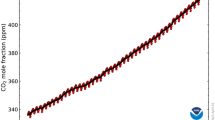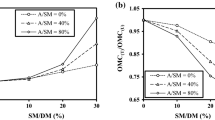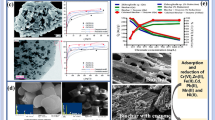Abstract
Leachate sludge is generated from the biochemical treatment sludge tank for disposing the leachate from landfill municipal solid waste (MSW). It has the characteristics of high water content and high organic matter content. Sulfoaluminate cement (SAC) is used as the main curing agent, and municipal solid waste incineration (MSWI) by-products are used as auxiliary curing agents to solidify/stabilize the leachate sludge. The influences of SAC content and MSWI by-products content on the strength and solidification mechanism of the leachate sludge are investigated by unconfined compressive strength (UCS) test and micro-observation tests. Moreover, the leaching concentration of heavy metals of the solidified samples is analyzed by leaching toxicity test. The results show that the UCS of the solidified samples increases with an increase in cement content. When the cement content is larger than 20%, the UCS of the solidified samples satisfies the strength requirement of landfill. The enhancing effect of bottom ash on the cement-solidified samples is slight. The fly ash is a good auxiliary curing agent for improving the UCS of cement-solidified samples, and the optimal dosage of fly ash is 5% and 15% for the solidified samples with 10 ~ 30% and 40 ~ 50% cement content, respectively. Ten percent fly ash can replace 10% cement to achieve better solidification effect for the solidified samples. The leaching concentration of heavy metals in the solidified sample with 30%/40% cement and 15% fly ash/bottom ash can satisfy the strength and leaching toxicity requirements of landfill. The immobilization of heavy metal of the cement and MSWI by-products solidified samples is mainly achieved through physical adsorption, physical encapsulation, ion exchange, and chemical precipitation.











Similar content being viewed by others
Data availability
Some or all data, models, or code that support the findings of this study are available from the corresponding author upon reasonable request.
References
Abunama T, Moodley T, Abualqumboz M et al (2021) Variability of leachate quality and polluting potentials in light of leachate pollution index (LPI) - a global perspective. Chemosphere 282:131119
Alexander M, Fourie C (2011) Performance of sewer pipe concrete mixtures with Portland and calcium aluminate cements subject to mineral and biogenic acid attack. Mater Struct 44(1):313–330
Balonis M, Lothenbach B, Le Saout G et al (2010) Impact of chloride on the mineralogy of hydrated Portland cement systems. Cem Concr Res 40:1009–1022
Cement Research Division, Research Institute of building Materials (1978) Hydration and hardening of sulfoaluminate cement and its properties. J Chin Ceram Soc 03:123–140+225
Chen JT (2020) Experimental study on solidification/stabilization of leachate sludge in landfill [D]. Guangdong University of Technology, Guangzhou
Chen H, Wang Q (2006) The behaviour of organic matter in the process of soft soil stabilization using cement. Bull Eng Geol Env 65:445–448
Chen Q, Hills C, Tyrer M et al (2007) Characterisation of products of tricalcium silicate hydration in the presence of heavy metals. J Hazard Mater 147:817–825
Chen Q, Tyrer M, Hills C et al (2008) Immobilisation of heavy metal in cement-based solidification/stabilisation: a review. Waste Manage 29:390–403
Chen P, Feng B, Zhan L (2014) Solidification of dewatered sewage sludge using bottom ash of MSWI as skeleton material. China Environ Sci 34(10):2624–2630
Chen W, Wang F, Li Z et al (2020) A comprehensive evaluation of the treatment of lead in MSWI fly ash by the combined cement solidification and phosphate stabilization process. Waste Manage 114:107–114
Cheng X, Wei C, Ke X et al (2022) Nationwide review of heavy metals in municipal sludge wastewater treatment plants in China: sources, composition, accumulation and risk assessment. J Hazard Mater 437:129267
Chinese Research Academy of Environmental Sciences (2008) GB 16889-2008 Standard for pollution control on the landfill site of municipal solid waste [S]. China Environmental Science Press, Beijing
Dorn T, Blask O, Stephan D (2022) Acceleration of cement hydration-a review of the working mechanisms, effects on setting time, and compressive strength development of accelerating admixtures. Constr Build Mater 323:126554
Du J, Liu B, Shen T et al (2020) Mechanical properties and constitutive relation of cement-stabilized organic matter-disseminated sand. Trans Chin Soc Agric Eng 36(2):140–147
Environment Agency (2010) Waste Acceptance at Landfills
Fan C, Wang B, Qi Y et al (2021) Characteristics and leaching behavior of MSWI fly ash in novel solidification/stabilization binders. Waste Manage 131:277–285
Feng G, Guo Y, Tan W (2015) Effects of thermal hydrolysis temperature on physical characteristics of municipal sludge. Water Sci Technol 72(11):2018–2026
Feng D, Wang J, Wang Y et al (2023) Experimental study on solidification/stabilisation of high-salt sludge by alkali-activated GGBS and MSWI bottom ash cementitious materials. Case Stud Constr Mater 19:e02417
Havukainen J, Zhan M, Dong J et al (2017) Environmental impact assessment of municipal solid waste management incorporating mechanical treatment of waste and incineration in Hangzhou, China. J Clean Prod 141:453–461
Jiang X, Ji G, Liu Y et al (2020) Overview of extracellular polymeric substance (EPS) generation and disaggregation in municipal sewage sludge. Chin J App Environ Biol 26(05):1282–1289
Lan T, Meng Y, Ju T et al (2022) Synthesis and application of geopolymers from municipal waste incineration fly ash (MSWI FA) as raw ingredient-a review. Resour Conserv Recycl 182:106308
Li X, Lv Y, Ma B et al (2012) Utilization of municipal solid waste incineration bottom ash in blended cement. J Clean Prod 32:96–100
Liang S, Feng D (2022) Experimental study on strength and water stability of concentrated solution sludge solidified with sulfoaluminate cement collaborating waste incineration by-products. Rock Soil Mech 43(6):1453–1468
Liang B, Hu X, Chen Y (2016) Engineering characteristics of municipal sludge solidified by municipal solid waste incineration bottom ash as an additive. J Environ Eng 10(11):6705–6710
Ministry of Environmental Protection of China (2010) HJ 564-2010 Leachate treatment project technical specification of municipal solid waste landfill [S]. China Environmental Science Press, Beijing
Ministry of Housing and Urban-Rural Development of the People’s Republic of China (2013) GB50869-2013 Technical code for municipal solid waste sanitary landfill [S]. China Planning Press, Beijing
Ministry of Water Resources of People’s Republic of China (2019) GB/T 50123-2019 Standard for geotechnical testing method [S]. China Planning Press, Beijing
National Bureau of Statistics of China (2022) China Statistical Yearbook-2022 [M]. China Statistics Press, Beijing
Qian G, Cao Y, Chui P et al (2006) Utilization of MSWI fly ash for stabilization/solidification of industrial waste sludge. J Hazard Mater 129(1–3):274–281
Quina M, Bordado J, Quinta-Ferreira R (2008) Treatment and use of air pollution control residues from MSW incineration: an overview. Waste Manage 28:2097–2121
Renou S, Givaudan J, Poulain S et al (2008) Landfill leachate treatment: review and opportunity. J Hazard Mater 150(3):468–493
Tan JW, De Vlieger J, Desomer P et al (2022) Co-disposal of construction and demolition waste (CDW) and municipal solid waste incineration fly ash (MSWI FA) through geopolymer technology. J Clean Prod 362:132502
Tang J, Su M, Wei L et al (2020) Comprehensive evaluation of the effectiveness on metals recovery and decontamination from MSWI fly ash by an integrating hydrometallurgical process in Guangzhou. Sci Total Environ 728:138809
Tremblay H, Duchesne J, Locat J et al (2002) Influence of the nature of organic compounds on fine soil stabilization with cement. Can Geotech J 39(3):535–546
Wang K, Daoji W, Yongzhen P et al (2018) Analysis on the status quo of landfill leachate treatment technology and application. J Beijing Univ Technol 44(1):1–12
Wang Y, Zhi L, Ma X et al (2020) Characterization of extracellular polymeric substances from aerobic granular sludge. J Harbin Inst Technol 52(02):153–160
Wiszniowski J, Robert D, Surmacz-Gorska J et al (2006) Landfill leachate treatment methods: a review. Environ Chem Lett 4(1):51–61
Wu C, Tang M, Zhang H et al (2021) Effect of the physicochemical properties of municipal sludge from different areas in China and their influence on dewatering performance. Chin J Environ Eng 15(01):271–278
Xing H, Yang X, Xu C et al (2008) Strength characteristics and mechanisms of salt-rich soil-cement. Eng Geol 103:33–38
Xu C, Guo H, Yang X et al (2009) Comparation analyses of the effects of marine soft soil improved by Portland cement and slag cement. Rock Soil Mech 30(9):2737–2740
Yu J, Qian J, Tang J et al (2019) Effect of ettringite seed crystals on the properties of calcium sulphoaluminate cement. Constr Build Mater 207:249–257
Yu L, Yan C, Guo S et al (2020) Study on the effect of organic content on properties of magnesium phosphate cement solidified soil. J Eng Geol 28(02):335–343
Zhang Y, Wang L, Chen L et al (2021) Treatment of municipal solid waste incineration fly ash: state-of-the-art technologies and future perspectives. J Hazard Mater 411:125132
Zhao H, Sun W, Wu X et al (2015) The properties of the self-compacting concrete with fly ash and ground granulated blast furnace slag mineral admixtures. J Clean Prod 95:66–74
Funding
The National Natural Science Foundation of China (grant number 52078142) and the Natural Science Foundation of Guangdong Province (grant number 2022A1515011047) provided financial support.
Author information
Authors and Affiliations
Contributions
Deluan Feng: conceptualization, methodology. Jie Wang: data curation, writing — original draft preparation. Dongyao Chen: test, date; Shihua Liang: writing — reviewing and editing.
Corresponding author
Ethics declarations
Ethical approval
Not applicable.
Consent to participate
Not applicable.
Consent for publication
Not applicable.
Competing interests
The authors declare no competing interests.
Additional information
Responsible Editor: Guilherme Luiz Dotto
Publisher's Note
Springer Nature remains neutral with regard to jurisdictional claims in published maps and institutional affiliations.
Supplementary Information
Below is the link to the electronic supplementary material.
Rights and permissions
Springer Nature or its licensor (e.g. a society or other partner) holds exclusive rights to this article under a publishing agreement with the author(s) or other rightsholder(s); author self-archiving of the accepted manuscript version of this article is solely governed by the terms of such publishing agreement and applicable law.
About this article
Cite this article
Feng, D., Wang, J., Chen, D. et al. Experimental study on solidification/stabilization of leachate sludge by sulfoaluminate cement and MSWI by-products. Environ Sci Pollut Res 31, 5071–5085 (2024). https://doi.org/10.1007/s11356-023-31470-z
Received:
Accepted:
Published:
Issue Date:
DOI: https://doi.org/10.1007/s11356-023-31470-z




